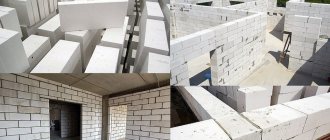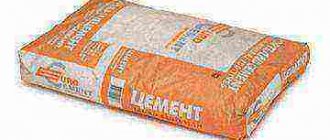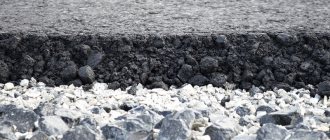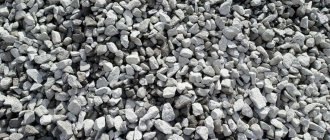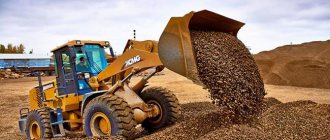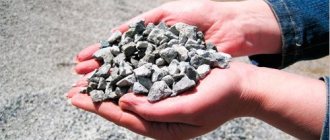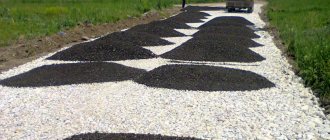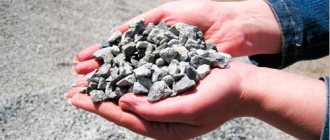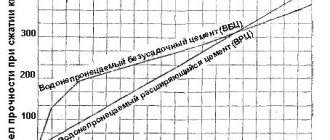1. General Provisions.
These technical specifications apply to crushed stone and sand, as well as crushed stone-sand mixtures from slag obtained from the smelting of carbon steel in an arc steel-melting furnace ____________________ intended for road construction (coverings, bases, additional base layers and other structural layers of road pavement).
In addition, these materials can be used as backfill for mines and quarries in industrial and civil construction. The use of slag materials is regulated by the rules and regulations for the design and construction of highways and other regulatory and technical documents.
Methods of production and types of products
Secondary slag crushed stone
Such building material as slag crushed stone is of artificial origin. It is not extracted from the bowels of the earth and is not specially produced. It is an industrial waste and is produced as a result of the combustion of fuel or metallurgical slag. Therefore, the costs of obtaining it are lower compared to other building materials. Among consumers, the most popular use is crushed stone obtained from blast furnace slag.
You can obtain slag crushed stone in several ways:
- Combustion. Crushed stone comes out as waste from the activities of boiler houses, metallurgical and chemical industries.
- Casting. The product is produced by a special method from molten metallurgical slag: the hot liquid mass is poured onto a prepared platform. This method allows you to get a more foamy and lighter product.
Next, the mass obtained by one of the methods is cooled, sifted and crushed. The final pieces may differ in size from each other. Therefore, they are sorted and collected into groups according to size:
- up to 5 mm – granules are too small, go to screenings, are used in construction as sand;
- from 5 to 20 mm – fine grain;
- from 20 to 40 mm – medium-sized granules;
- from 40 to 70 mm and from 70 to 120 mm - large fractions.
Its bulk density depends on the size of crushed stone. The smoother and finer the grain, the tighter it fits together. The bulk density of crushed stone affects its characteristics and properties, and the industry of use of the product depends on it.
Acceptance rules.
5.1. Crushed stone and sand produced by the plant must be accepted by the quality control department.
5.2. Acceptance of crushed stone and sand is carried out in batches. A batch is considered to be the amount of crushed stone of one fraction (mixture of fractions), and for sand - one size module, simultaneously shipped to one consumer in one train. When shipping by road, a batch is considered to be the amount of crushed stone of one fraction, and for sand - one module, shipped to one consumer within 24 hours.
5.3. To verify compliance of the quality of crushed stone and sand with the requirements of this standard, acceptance and periodic tests are carried out.
Acceptance control is carried out daily by testing a representative sample of crushed stone (sand).
During acceptance tests, the following is determined: for crushed stone and sand, the grain composition, the content of dust particles and the level of radioactivity.
5.4. During periodic testing, check:
- once every ten days - the shape of the grains, the content of metallic inclusions, losses on ignition,
- once a quarter - stability of the structure against decay, sulfide sulfur content, strength, bulk density,
- once a year - frost resistance.
5.5. Selection and preparation of crushed stone samples for quality control is carried out in accordance with GOST 8269, sand in accordance with GOST 8735.
5.6. A batch of crushed stone and sand is considered accepted based on the results of acceptance and periodic tests if the values of the indicators comply with the requirements of this Specification.
If the test results are unsatisfactory for at least one indicator, repeated tests are carried out on it. The result of the retest is final.
5.7. The amount of crushed stone and sand supplied is determined by weight or volume. Conversion of quantities from volume units to mass units is carried out based on the bulk density value.
Slag crushed stone
Essentially, this raw material is waste that is obtained during the crushing of rocks. The cost of such screenings is much lower, so thanks to this material it is possible to significantly reduce the cost of construction work.
Crushed stone and gravel are used in almost all construction work. These naturally occurring minerals are formed from rocks.
Waste gravel is used both in the manufacture of reinforced concrete structures and in the design of a section of gravel path as in the photo, sports grounds, flower beds and much more.
To determine the difference between gravel and crushed stone, consider the features of another building material.
Control methods.
6.1. The grain composition of crushed stone, the content of dust particles and frost resistance are determined according to GOST 8269.
6.2. The content of metal inclusions in crushed stone and sand is determined according to GOST 3344.
6.3. The stability of the structure of crushed stone and sand against silicate decomposition and losses on ignition are determined according to GOST 9758.
6.4. The total content of sulfur and sulfuric acid compounds is determined according to GOST 8735.
6.5. The level of radioactivity is determined using DRS - PM1401. Search dosimeter, microprocessor.
6.6. It is allowed to use other methods during testing that do not reduce the accuracy of the determination.
Properties and characteristics
As you know, any thing can be characterized:
- As for the size of crushed stone, they are described by the word “fraction”. But what is it? The fraction of building crushed stone determines the minimum and maximum sizes of crushed stone particles. There are also already defined fraction boundaries, which are considered for each type of crushed stone separately.
- Frost resistance of crushed stone is determined as Fn. Where F is the cycle of saturation in a solution of sodium sulfate and subsequent drying, and n is the number of such series. For the most part, during construction it is customary to use crushed stone no worse than F300, that is, it must have 300 permissible cycles of freezing and subsequent thawing.
- Flakiness means that a batch of “seeds” contains certain shapes, which are called needle-shaped, lamellar and cuboidal. The best compaction is achieved by the shape in the form of cubes, so it is in good demand on the market for construction crushed stone. This is due to the fact that, due to its shape, such crushed stone takes up more space, which ultimately does not require extra spending on an adhesive. However, in the construction of roads, needle-like, that is, flaky crushed stone can also be used, since it is better able to repel water, that is, it drains better.
- Like any building material, crushed stone must also have strength characteristics. This parameter determines how strong the concrete will be and whether it can withstand loads without changing its shape and properties. Here crushed stone can be divided into five types:
- M1200-1400 is considered the most durable crushed stone.
- M800-1200 can be called strong.
- Average strength crushed stone has an index of M600-800.
- “Flimsy” is an indicator in the range of M300-600.
- In addition to these indicators, it is worth noting the minimum permissible strength with an indicator of M200.
- In addition to the fraction, there is one more point - the radioactivity of crushed stone. Here crushed stone is divided into three classes, which determine the scope of its application:
- The third class is considered crushed stone with radioactivity above 740 Bq/kg. This material is used for the construction of roads strictly away from populated areas, as it can harm the population.
- The second class can be called an indicator from 370 to 740 Bq/kg. Such crushed stone is used in industry and road construction already in cities, but it is still not recommended to use it indoors due to its radioactivity.
- And finally, the first class, the radioactivity of which should not exceed 370 Bq/kg. This class of material is suitable for any construction work, even indoors, and is relevant in the crushed stone market.
Transportation and storage.
8.1. Crushed stone and sand are transported in bulk in vehicles of any type in accordance with the current rules for the transportation of goods and technical conditions for loading and securing goods, approved by the Ministry of Railways, rules for transportation by road and water transport.
When transporting crushed stone and sand by rail, wagons should be loaded taking into account the full use of their carrying capacity.
7.2. Crushed stone is stored separately by fraction, sand - by size modulus under conditions that protect them from clogging and contamination.
Receiving blast furnace slag
Blast furnace slag is obtained during the smelting of cast iron as a result of fusing clay and other impurities included in the ore and fuel with lime obtained by burning limestone introduced into the blast furnace. Depending on the composition of the charge used in the production of cast iron, basic or acidic slag is obtained. The basic slag is considered to be the composition of which, expressed as a percentage, is characterized by a basicity modulus Mo exceeding 1: Mo = CaO + MgO divided by SiO + Al2O3 > 1
Acid slag has Mo<1. The main slags are obtained, for example, when cast iron is smelted using Donetsk coke, which contains a significant amount of sulfur. When smelting with low-sulfur but higher ash Kuznetsk coke, acidic slags are obtained.
Cooperation with TEMP LLC
The Taganrog Experimental Industrial Project produces crushed stone from blast furnace slag. The material of various fractions (0.5–70 mm) is used in road construction and the production of concrete structures, when pouring foundations and laying drainage for sports facilities, for decorative design of urban spaces or creating a primary coating on primers.
TEMP LLC provides wholesale supplies of crushed stone to any point in Russia by road, rail, sea or river transport. The cost of material of different fractions can be checked with managers by calling 8-8634-43-05-80 (Taganrog) and 8-495-125-01-06 (Moscow) or in the catalog on the company website. Deliveries of large quantities are carried out under special conditions.
Metallurgical slag fillers
Metallurgical slags are a significant reserve for providing the construction industry with aggregates for concrete. Slag fillers can be heavy (p0 > 1000 kg/m3) and light (p0 < 1000 kg/m3) in terms of bulk density, and small (< 5 mm) and coarse (> 5 mm) in terms of grain size.Slag crushed stone. Slag crushed stone is obtained by crushing waste metallurgical slag or special processing of fiery liquid slag melts (cast slag crushed stone). For the production of crushed stone, dump slags, steel smelting slags (acceptable for processing into crushed stone), as well as copper smelting, nickel and other non-ferrous metallurgy slags are mainly used.
Effective types of heavy concrete aggregates, which are not inferior in physical and mechanical properties to the products of crushing dense natural stone materials, include cast slag crushed stone. In the production of this material, fiery liquid slag from slag ladles is poured in layers 250–500 mm thick onto special casting platforms or into trapezoidal pit-trenches (2.8). When kept in open air for 2-3 hours, the temperature of the melt in the layer decreases to 800 °C and the slag crystallizes. It is then cooled with water, which leads to the development of numerous cracks. Slag masses on linear platforms or in trenches are developed by excavators, followed by crushing and screening.
Physico-mechanical properties of cast slag crushed stone:
Average density of pieces, kg/m3…. . 2200—2800
True density, kg/m3 2900—3000
Ultimate compressive strength, MPa 60—100
Water absorption, wt% 1-5
Bulk density of crushed stone, kg/m3 1200—1500
Cast slag crushed stone
characterized by high frost and heat resistance, as well as abrasion resistance. Its cost is almost 2 times less than crushed stone made from natural stone. For the manufacture of concrete and reinforced concrete products, fractionated cast slag crushed stone with a particle size of 5–70 mm is used. Unsorted material is used in road construction and in the production of mineral wool, and screenings can serve as a filler for refractory concrete and partially replace granulated slag in the production of Portland slag cement. To obtain cast dense slag crushed stone with a crystalline structure, “low gas” fire-liquid slags are used, in which, upon cooling, a minimum number of pores is formed, and the average density of the pieces is not less than 2200 kg/m3.
A necessary condition for obtaining fillers from metallurgical slag is their resistance to various types of decomposition. Silicate decomposition, characteristic of high-calcium, low-manganese and low-alumina slags, is especially dangerous.
The polymorphic transformation of calcium orthosilicate, the main reason causing this form of decomposition, can occur when the slag cools slowly. Therefore, the main way to stabilize slags prone to silicate decomposition is their rapid cooling (thermal stabilization); for example, draining slag melts in a thin layer from the slope of a slag mountain or granulation.
In addition to thermal, methods of chemical and crystal chemical stabilization have also been developed, based on the introduction of additives into the melt that promote the formation of stable compounds. With the chemical method, additives (clay, sand) are usually introduced into the melt, binding calcium oxide and promoting the crystallization of stable minerals (gelenite, okermanite, etc.). The essentially by 38%) when water acts on iron sulfide and forms iron hydroxide.
The decomposition of slag begins during the cooling process and is completed in dumps within 2-3 months. Slags that have lain in dumps for a long time and have no signs of decay are considered stable.
To quickly assess the resistance of slags to silicate decomposition, the sample is steamed over boiling water or in an autoclave at a pressure of 0.2 MPa. Slag crushed stone is considered resistant to silicate decomposition if the mass loss for the tested fraction does not exceed 5%. The tendency to silicate decomposition can be determined by irradiating slag with ultraviolet rays (luminescence method). Slags prone to silicate decomposition are distinguished by a yellow or golden glow, while slags that are stable have a purple glow of various shades.
Resistance to ferrous decomposition is established by keeping crushed slag stone in distilled water for 30 days. The weight loss in this case, as well as when testing for silicate decomposition, should not exceed 5%.
To prevent lime and magnesium decomposition in slag processed into aggregates, free oxides of calcium and magnesium are not allowed.
A preliminary assessment of the stability of the blast furnace slag structure is made by knowing its chemical composition.
Depending on the grain size, crushed stone is divided into fractions: 5-10, 10-20, 20-40, 40-70, 70-120 mm. The grain composition of slag crushed stone, like other types of filler, is selected to ensure minimal voids. The minimum bulk density of crushed stone of each fraction is 1000 kg/m3. The content of lamellar (flaky) and needle-shaped grains should be for crushed stone: cuboid - no more than 15%; improved - 25; regular - 35%. The length of such grains is three or more times greater than their thickness or width.
The strength of slag crushed stone is characterized by its grade. For crushed stone from blast furnace sludge used as a filler for heavy concrete, five strength grades have been established:
Crushed stone grade by strength 1200 1000 800 600 300
Weight loss after testing, % Up to 15 15-25 25-35 35-45 45-55
Crushed stone grade Ml200 can be used in the production of concrete grade M400 and above, M1000 - grade MZOO, M800 - grade M200 and M600 - below grade M200. Low-grade crushed stone is also used in the production of concrete of higher strength, but after appropriate testing and a feasibility study.
Depending on the number of cycles that crushed stone can withstand during testing, its frost resistance grades are established.
The content of elutriable dust and clay particles in slag crushed stone should be no more than 3% for weakly active and inactive slag. For active and highly active slags, the content of elutriable impurities is not standardized. It is unacceptable to contain impurities of fuel slag, ash, and flue dust in crushed stone.
The clay content in lumps in crushed stone from slag of all types should not be more than 0.25% by weight.
Metallurgical slag contains sulfur, which causes corrosion of reinforcing steel. In crushed stone from blast furnace slag its content should not exceed 2.5% by weight. The presence of sulfur must be taken into account in the production of prestressed reinforced concrete structures, where the possibility of using slag crushed stone must be justified by special research.
Along with dense waste slag, porous slag is used for the production of crushed stone, formed from melts with high gas saturation, swelling with bubbles of released gases. The strength of porous dump slag is 2.5–40 MPa; the average density in a piece is 400–1600 kg/m3, which makes it possible to provide a bulk density of crushed stone of 800 kg/m3 or less and use it for the production of lightweight concrete.
The physical and mechanical properties of slag crushed stone vary over a wider range than crushed rock, which is due to fluctuations in the quality of raw materials and technological parameters.
Slag crushed stone is used not only as a filler for cement concrete, but also in road construction to strengthen foundations and construct asphalt concrete pavements. Depending on the structural features, abrasion resistance and crushability, crushed slag stone is divided into grades:
Crushed stone grade for abrasion I1 II ISH MIV
Weight loss during testing, % <25 25-35 35-45 45-60
The grade of crushed stone from metallurgical slag as a filler for asphalt concrete depends on the type of mixture. It should be, for example, for mixtures of grade I:
— for hot and warm asphalt concrete types A, B and C, respectively 1200, 1000 and 800;
- cold - types Bx and Bx - 800 and 600;
— porous — 800.
Slag and mineral mixtures
. Slag-mineral mixtures include stone materials reinforced with granulated blast furnace slag and intended for constructing highway foundations. To activate slags and harden mixtures, additives of slaked lime (1-3%) or Portland cement (3-5%) are added to their composition. Slag-mineral mixtures activated with slaked lime slowly set and harden, which allows gaps of several days between preparing the mixture and its placement in the bases. Slag-mineral mixtures activated by cement set faster and allow construction work to be carried out within 6-8 hours.
Slag-mineral mixtures laid in the base layer require virtually no special maintenance and allow movement to begin immediately after compaction. They allow the laying of asphalt concrete pavements immediately after compaction of the base. When constructing bases from slag-mineral mixtures on roads of higher categories, you can use not only local low-strength stone materials, but also sand and gravel mixtures.
The slag-mineral base is more rigid than the bitumen-mineral base, but it is much more flexible and deformable than bases made of cemented materials, including concrete.
In terms of crack resistance, the slag-mineral base is inferior to the bi-tumor-mineral base and transverse cracks appear in it when there are temperature changes. In the southern regions and with sufficiently thick layers of asphalt concrete pavement, cracking in the slag-mineral base can be avoided.
In road construction practice, compositions of slag-mineral mixtures have proven themselves well, in which the consumption of granulated slag varies from 10 to 20%.
The mineral part of the mixtures is selected according to the dense mixture curves recommended for bitumen-mineral mixtures.
Slag and mineral mixtures
, mixed with 8-9% water, mix well and compact easily. An asphalt concrete coating laid on a slag-mineral base combines well with it.
Road construction is the most material-intensive area of application of slag crushed stone. The requirements for slag crushed stone depend on the layer of road pavement where it is used. Thus, the material laid in the underlying layer must be waterproof and frost-resistant, crushed stone for the base must have a rough surface. When compacted, road construction material must have high shear strength. To ensure movement at the set speed, coatings must have high wear resistance and maintain evenness. One of the main requirements for crushed stone for road construction is its ability not to crush during laying and compaction.
Crushed stone from unsorted waste slag is used in road embankments and underlying layers. Unfractionated slag crushed stone is also suitable for constructing thrust prisms of dams and dikes, strengthening their slopes subject to wave action. Crushed stone from blast furnace and steel-smelting slag is easily rolled into road bases, cemented and forms a monolithic layer, especially when mixed with crushed stone from weak limestone rocks. Crushed stone from open-hearth slag is successfully used for wedging bases made of granite crushed stone, which is difficult to roll.
The most economical designs are those using steel slag with a particle size of up to 40 mm. During operation, the elastic modulus of the layers at the base slowly increases due to an increase in strength. The use of slag with an activator (calcium chloride) makes it possible to carry out road work in winter.
Waste slag and mineral powder from steel-smelting slag are successfully used in the preparation of asphalt concrete for the top layers of road pavements. Asphalt concrete pavements with slag filler are characterized by high strength, abrasion resistance, a high coefficient of adhesion, and the absence of shear deformations. Also, these coatings are characterized by increased resistance to impact loads at positive and negative temperatures, and greater heat resistance than asphalt concrete based on natural mineral aggregates. With prolonged contact with water, the pores of the slag material grow with crystalline-hydrate new formations, which prevents subsequent access of water into them and leads to an increase in the frost resistance of asphalt concrete.
The disadvantage of slag asphalt concrete mixtures is their high average density, which is 15-25% higher than the density of mixtures made from natural materials.
Slag filler
. High-quality mineral powder is obtained from steelmaking slag, which is an important structure-forming component (filler) of asphalt concrete. The share of mineral powder accounts for 90-95% of the total surface of mineral grains that make up the asphalt concrete. Its main purpose is to convert bitumen into a film state, as well as to fill the pores between large particles, resulting in increased density and strength of asphalt concrete. Mineral powder from steel-smelting slag is characterized by a more developed surface than powder from carbonate materials and, as a consequence, higher swelling in a mixture with bitumen.
Mineral powder increases the strength of asphalt concrete, but at the same time increases its fragility, so its content in the mixture should be extremely minimal, sufficient only to give the asphalt concrete the required density and strength. Increasing the mass fraction of mineral powder in the mixture above the required minimum reduces the crack resistance of coatings and sharply reduces their shear resistance.
Finely ground slags, which have hydraulic activity, i.e. the ability to chemically bind Ca (OH) 2 even at normal temperatures, are effective fillers (microfillers) in cement concrete.
Cement stone, as defined by V.N. Jung, can be considered “micro-concrete”. A significant part of the cement grains is not completely hydrated and acts as a kind of cement stone fillers. The depth of hydration of individual clinker minerals is not the same and, as follows from the data of Yu.M. Butta even at 6 months. for the most active mineral C3S does not exceed 15 µm, and for the least active mineral C2S - 2.7 µm.
Numerous studies have shown that in addition to “natural” fillers, which are the cores of most clinker particles, “artificial” fillers can be successfully introduced into cements and concrete mixtures - finely ground, practically insoluble inorganic substances in water, consisting of particles less than 150 in size. µm.
Possessing a high specific surface area, fillers, along with direct chemical effects, affect the physical and chemical processes at the interface. In accordance with the Gibbs-Volmer
the energy of formation of crystal nuclei is significantly reduced in the presence of crystallization centers, which can serve as filler particles.
By reducing the radius of filler grains and the surface tension at the crystal-liquid phase interface, the probability of the nucleation of a new phase can be significantly increased. With optimal concentration and dispersion of the filler, a fine-grained structure of the binder is formed, which has a beneficial effect on the technical properties of the artificial stone. When a filler is introduced into the cement-water system, the hardening rate and strength increase until all filler grains remain surrounded by hydration products. For silica particles, the degree of filling can be determined by the amount of CaO that can bind 1 g of filler. The degree of filling calculated in this way ranges from 5 to 10% of the cement mass.
With an excess of filler with highly dispersed grains, areas of self-stress appear, which, as crystals grow, can lead to the formation of cracks and other violations of the homogeneity of the microstructure.
The filler must provide maximum adhesive strength between the binders and the filler and the cohesive strength of the binder, minimum voids due to the displacement of cement paste into the contact zone and the overall voids of the concrete as a whole. In this case, the degree of filling must be such that at the initial stage of structure formation the specified rheological parameters of the mixture are ensured.
Light slag aggregates
. Granulated slag is used in concrete as a fine aggregate. In terms of grain composition, it corresponds to coarse sand. Approximately 50% of its mass consists of grains larger than 2.5 mm. The bulk density of granulated slag depends on the properties of the molten slag and granulation technology and is 600–1200 kg/m3. Granules formed during rapid cooling of molten slag with water or a steam-air mixture are characterized by a high content of glassy phase and porosity.
Granulated slag
is an effective filler for ordinary and fine-grained concrete, and can serve as a coarsening additive for enriching natural fine sands. Porous varieties of granulated slag are used as lightweight concrete fillers.
Slag pumice
- one of the most effective types of artificial porous aggregates. It is obtained by porous slag melts as a result of their rapid cooling with water, air, steam, as well as exposure to mineral gas-forming agents. The following mechanisms of melt porization are possible: swelling by the rise of gas bubbles in the molten mass; swelling by mixing the melt with porous gases.
The structural features of slag pumice depend on the properties and composition of the melt being porous, as well as on the nature of the gases and their quantity. The initial melts can have a varied chemical composition, but must be resistant to all types of decomposition. The temperature of the melt entering the porous process is at least 1250 °C, and the viscosity should not exceed 5 Pas.
Porization of the melt occurs when it is oversaturated with gases, which occurs due to a decrease in their solubility and crystallization of the melt.
The production of slag pumice has been mastered using the following methods: spray-trench, pool, water-blown and hydroscreen.
The simplest and most productive is the spray-trench method. However, its disadvantages are the uneven porosity of the resulting material, heterogeneity, and the need to allocate large areas for trenches.
The water-blowing (jet) method involves crushing slag and mixing it with water in specially designed apparatus using compressed air or steam.
When using the pool method, the molten slag is poured into a stationary or tilting metal pool, into which water is supplied through a perforated bottom under a pressure of 0.4-0.6 MPa. Under the influence of the generated steam and released gases, swelling of the melt occurs. The resulting blocks of porous material are crushed and dispersed into fractions. Stationary and tipping installations differ in the method of unloading: in the first, it is performed using excavators or scrapers, and in the second, by tipping the pool.
The most effective currently is the hydroscreen method, based on sudden cooling of the molten slag in a system of sequentially installed hydraulic troughs, consisting of troughs and hydromonitor nozzles 3, 5, through which water is supplied. A screen is installed between the hydraulic gutters.
The intumescent slag melt from the chute 2 is thrown out by jets of water onto the screen 4, reflected from which, it hits the chute 6, from where it is carried by water to the conveyor loader 7 for subsequent cooling and crushing.
Slag pumice is produced in the form of crushed stone of three fractions (5-10, 10-20 and 20-40 mm) and sand (ordinary with grains of less than 5 mm, fine - less than 1.25 and coarse - 1.25-5 mm). For each fraction of crushed stone, as well as fine and coarse sand, the grain composition is standardized.
Depending on the bulk density (kg/m3), slag pumice is divided into grades: for crushed stone - 400, 450, 500, 550, 600, 650, 700, 750, 800, 850, 900; sand - 600, 700, 800, 900, 1000.
There is a certain relationship between the strength of crushed stone and its bulk density grade:
Crushed stone grade by bulk density 400 450 500 550 600 650 700 750 800 850 900
Compressive strength in a cylinder, MPa, not less than 0.3 0.35 0.40 0.45 0.55 0.65 0.70 0.90 1.1 1.3 1.5 ;
The grade of crushed stone made from slag pumice in terms of frost resistance is determined by the number of cycles of alternating freezing and thawing, during which the weight loss of the test sample should not exceed 8%. The frost resistance of crushed stone made from slag pumice must be at least 15 cycles.
The pore size of slag pumice depends on the production method and is 0.04–4.5 mm, porosity is 52–78, water absorption is 10–55%. Promising is gravel-like slag pumice, which has a dense vitrified shell of grains. Its use makes it possible to reduce cement consumption and reduce the average density of lightweight concrete.
When producing gravel-like slag pumice, melt particles from an air granulator are directed to a screen, where they are combined into larger pieces. In a rotating drum with longitudinal blades, additional swelling and rolling of the grains occurs, giving them a gravel-like shape. The quality indicators of such slag pumice are 2-3 times higher than those of porous slag crushed stone.
Slag pumice is used as a filler for lightweight concrete with a wide range of average density and strength properties. It is used as a porous filler for structural and thermal insulating lightweight concrete with a density of 1300-1600 kg/m3 and a strength of 5-7.5 MPa and structural concrete with a density of 1500-1800 kg/m3 and a strength of 10-20 MPa. When using slag pumice for reinforced and especially prestressed structures, the resistance of the reinforcement, corrosion of which is possible due to the sulfur contained in the slag, must be checked.
The cost of producing 1 m3 of this material is 5 times less, labor productivity is 4-5 times higher than in the production of other porous aggregates. Practically no process fuel is consumed to produce slag pumice. Electricity consumption for the production of 1 m3 of crushed stone and sand from slag pumice is 6.2 kW • h, and for the production of 1 m3 of expanded clay gravel - 24, agloporite - 47.4 kW • h.
At NIISM im. S.A. Dadashev developed a technology for producing artificial porous aggregates - azerites from glass wool slags of metallurgical and chemical industries and other inorganic industrial wastes. It makes it possible to obtain fillers with a bulk density of 430–765 kg/m3 and a compressive strength in a cylinder of 3.7–13.8 MPa. At the same time, the swelling temperature of raw granules decreases from 1150–1180 to 850–1000 °C. Based on the produced lightweight aggregates, it is possible to obtain high-strength lightweight concrete grades M100-M500 (classes B7.5-B40) for load-bearing structures of buildings and structures.
Slag insulation technology
Each surface has its own characteristics of insulation with slag fillers. General list of insulation stages :
- surface cleaning, repair of cracks and chips;
- surface treatment with antiseptic compounds (if wooden surfaces or any other surfaces are insulated, but sawdust is used as insulation);
- laying a vapor barrier, if required by the surface or filler (for example, when insulating a ceiling or floor);
- if necessary, guide beacons are installed;
- backfilling and leveling of insulation;
- pouring insulation with a binder, for example, cement laitance.
When insulating a ceiling or attic, the size of the slag layer is calculated taking into account the load on the structure . When insulating the floor, the recommended thickness of the filler is at least 40 cm.
Which is better and cheaper: gravel or crushed stone?
Due to its irregular shape, crushed stone forms a more reliable adhesion to the mortar than gravel. Thus, in terms of performance, crushed stone is significantly better than gravel.
The main advantage of gravel can be considered a lower price. It is about 20% cheaper than crushed stone, which is why it is often chosen as a filler when producing heavy concrete. Gravel is often used to build low houses on summer cottages and even to form a foundation.
What to choose - crushed stone or gravel - also depends on the properties of concrete. When the concrete is very strong, it is advisable to use crushed stone. For concrete with a moderate level of strength, inexpensive gravel is suitable.
